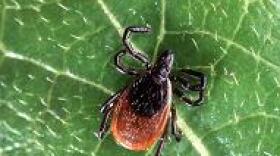As the summer season sets in, the Northeast is on alert for ticks. The Cary Institute of Ecosystem Studies recently co-hosted a panel discussion on Lyme and other tick-borne diseases.
Democratic New York state Assemblymember Didi Barrett co-hosted the forum June 14th at the Millbrook-based Cary Institute. It comes as a Cary scientist is in the midst of a project in Dutchess County while Barrett is working on legislation and raising awareness. It was part of Barrett’s #GetTickedOff social media campaign to push for legislative, policy and budgetary actions to grapple with the epidemic of Lyme and tick-borne diseases.
“It’s a huge issue. And I think that New York should be doing a much better job of leading around this because, as you saw on those maps, the density here,” Barrett says. “And we’ve been frustrated because I think often we feel like the recognition of chronic Lyme, the pervasiveness of it, the frustrations that people have, the lack of Lyme-literate doctors, none of that is necessarily on the radar screen of all of our leaders in the health and environmental communities. And it is an environmental issue, and that’s why I was so happy to do this at the Cary Institute.”
Dr. Rick Ostfeld is a disease ecologist with the Cary Institute and one of the panelists. He spoke about the Tick Project, a five year study with Bard College that runs through 2021 that has recruited 951 households from 24 neighborhoods throughout Dutchess County, which has one of the nation’s highest Lyme disease infection rates.
“And now we’re fully in the swing of things where we are pestering them every two weeks to ask them whether they or anyone in their household, including dogs and cats, have found ticks on them or gotten a case of tick-borne disease. We’re sampling ticks in their yards, both the ones that are crawling around trying to bite them and the ones that have found a mouse or a chipmunk host of some kind,” says Ostfeld. “And we’re now in year two of the tick-killing interventions. So things are going well. We don’t have results.”
And here’s why:
“One of our interventions, this tick-killing fungus, acts right away, within a week or two of spraying it on the yard. But the other one takes about a year before it’s effective because you put out these bait boxes. That kills the baby ticks that are on mice and chipmunks and shrews in one summer. And those are the ticks that, if they survive, will come out the next year as infected nymphs capable of making us sick,” says Ostfeld. “So if they were effective in 2017, we should see vastly reduced tick populations in 2018. That’s what we’re testing right now.”
He says the first results will be ready at the end of this year’s tick season, around late summer/early fall, on the impact on ticks. Ostfeld expects results pertaining to tick-borne illnesses to take another year or two.
“Based on samples of tens of thousands of ticks that we’ve looked at, about 1 in 3 of the nymph-stage ticks carries the Lyme disease pathogen,” Ostfeld says.
Ostfeld says the nymph is responsible for most cases of Lyme and other tick-borne illnesses. It was an answer to a question from Rhinebeck resident Lawrence Miller.
“I mean, it was just like I said, it was to allay my freak-out factor because, as far as I’m concerned, the Hudson Valley is paradise. I’ve been here 16 years. I do not intend to ever leave except for the ticks,” Lawrence says. “It’s my one black mark on the area, literally.”
Some audience members asked whether they could purchase Met52, the fungal spray. Ostfeld offered two reasons why that would be difficult.
“We’re still in the midst of testing whether it works when deployed in this way. So it’s hard to recommend on the basis of the small-scale field trials that have been done when we’re doing what we think is the definitive experiment,” says Ostfeld. “But the other reason is that the supply has crashed apparently because marijuana growers out in California are using it as the spray of choice to kill he pests that bother their crops in their pot-growing greenhouses.”
Barrett, who represents portions of Columbia and Dutchess Counties, says she is working on various pieces of legislation.
“So we have this bill, which would be a study bill looking at insurance coverage and costs around that and patient experiences and patient needs. And I think that’s something that I’m hoping that we’ll able to get passed because starting, at least if you start it with a study then there’s an opportunity to sort of explore all these directions without everybody getting defensive. So that’s our goal at this point,” says Barrett. “We also have this, the bill that calls for the state parks and recreational areas to have signs.”
Barrett hopes the Assembly will pass the bill about warning signs at state parks this week, during the session’s final three days. She says the Senate already passed the bill. Barrett also is working on the insurance study bill with Republican state Senator Sue Serino, who, over the weekend, held her own educational event on tackling ticks with the The Mid-Hudson Children’s Museum. Serino is chair of the Senate’s Task Force on Lyme and Tick-Borne Diseases.









